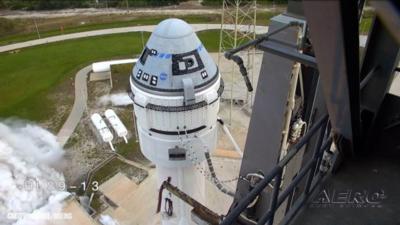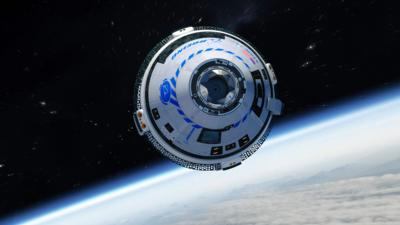Mon, May 06, 2024
Suni Williams Named The Crew Capsule Calypso In 2019
NASA astronauts Butch Wilmore and Suni Williams will be the first to fly aboard Boeing’s Starliner spacecraft to the International Space Station, and the name of the spacecraft ferrying them to the orbiting laboratory holds a special place in Williams’ heart.

Williams named the crew capsule Calypso in 2019 to pay tribute to the explorer Jacques Cousteau, who sailed across the world on his own ship named bearing the same name. Cousteau’s goal was to learn about the ocean and teach others about the wonders of the sea. Williams believes Starliner can do the same for space.
The spacecraft, on a United Launch Alliance Atlas V rocket, is scheduled for liftoff at 10:34 p.m. EDT Monday, May 6, from Space Launch Complex-41 at Cape Canaveral Space Force Station in Florida -- and by the way, the last time an 'Atlas' launched an astronaut (albeit a much earlier version)... it was for Project mercury...

The much updated Starliner spacecraft, with a diameter of 15 feet, can carry up to four astronauts, or a mix of crew and cargo, for NASA missions to low Earth orbit for the agency’s Commercial Crew Program heretofore dominated by the SpaceX Falcon/Dragon combo.
NASA’s Boeing Crew Flight Test mission to send two of the agency’s astronauts to the International Space Station is in the final stages of prelaunch operations. Starliner rolled from ULA’s Vertical Integration Facility to the launch pad at Space Launch Complex-41 at Cape Canaveral Space Force Station on May 4, in preparation for launch. The 45th Weather Squadron predicts a 95% chance of favorable weather conditions for launch, with the cumulus cloud rule being the primary weather concern.
NASA astronauts Butch Wilmore and Suni Williams are the first to launch aboard Starliner to the International Space Station as part of the agency’s Commercial Crew Program. The astronauts will spend about a week at the orbiting laboratory before returning to Earth and making a parachute and airbag-assisted landing in the southwestern United States.
After successful completion of the mission, NASA will begin the final process of certifying Starliner and its systems for crewed rotation missions to the space station.
More News
From 2023 (YouTube Edition): "Ain’t Your Daddy’s Super Cub”—Don Wade Co-owned by Don and Ron Wade—the former of Don’s Dream Machines, a storied >[...]
Pilot-Rated Passenger Reported That The Pilot Did Not Adequately “Round Out” The Landing Flare And The Airplane Bounced And Yawed To The Right Analysis: The pilot state>[...]
Dead Reckoning Dead reckoning, as applied to flying, is the navigation of an airplane solely by means of computations based on airspeed, course, heading, wind direction, and speed,>[...]
Aero Linx: Lake Amphibian Club This website is created and sponsored by the Lake Amphibian Club, to help spread the word about these wonderful, versatile amphibians that can land j>[...]
“I am deeply honored to be sworn in as NASA administrator. NASA’s mission is as imperative and urgent as ever — to push the boundaries of human exploration, ignit>[...]
 Classic Aero-TV: In Praise of Alabamas Patriot Aircraft USA
Classic Aero-TV: In Praise of Alabamas Patriot Aircraft USA NTSB Final Report: Cirrus Design Corp SR22
NTSB Final Report: Cirrus Design Corp SR22 ANN's Daily Aero-Term (12.21.25): Dead Reckoning
ANN's Daily Aero-Term (12.21.25): Dead Reckoning ANN's Daily Aero-Linx (12.21.25)
ANN's Daily Aero-Linx (12.21.25) Aero-News: Quote of the Day (12.21.25)
Aero-News: Quote of the Day (12.21.25)




